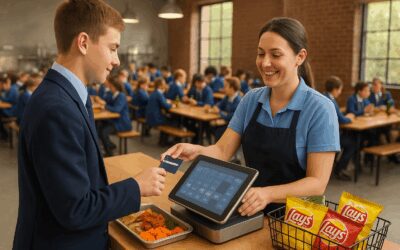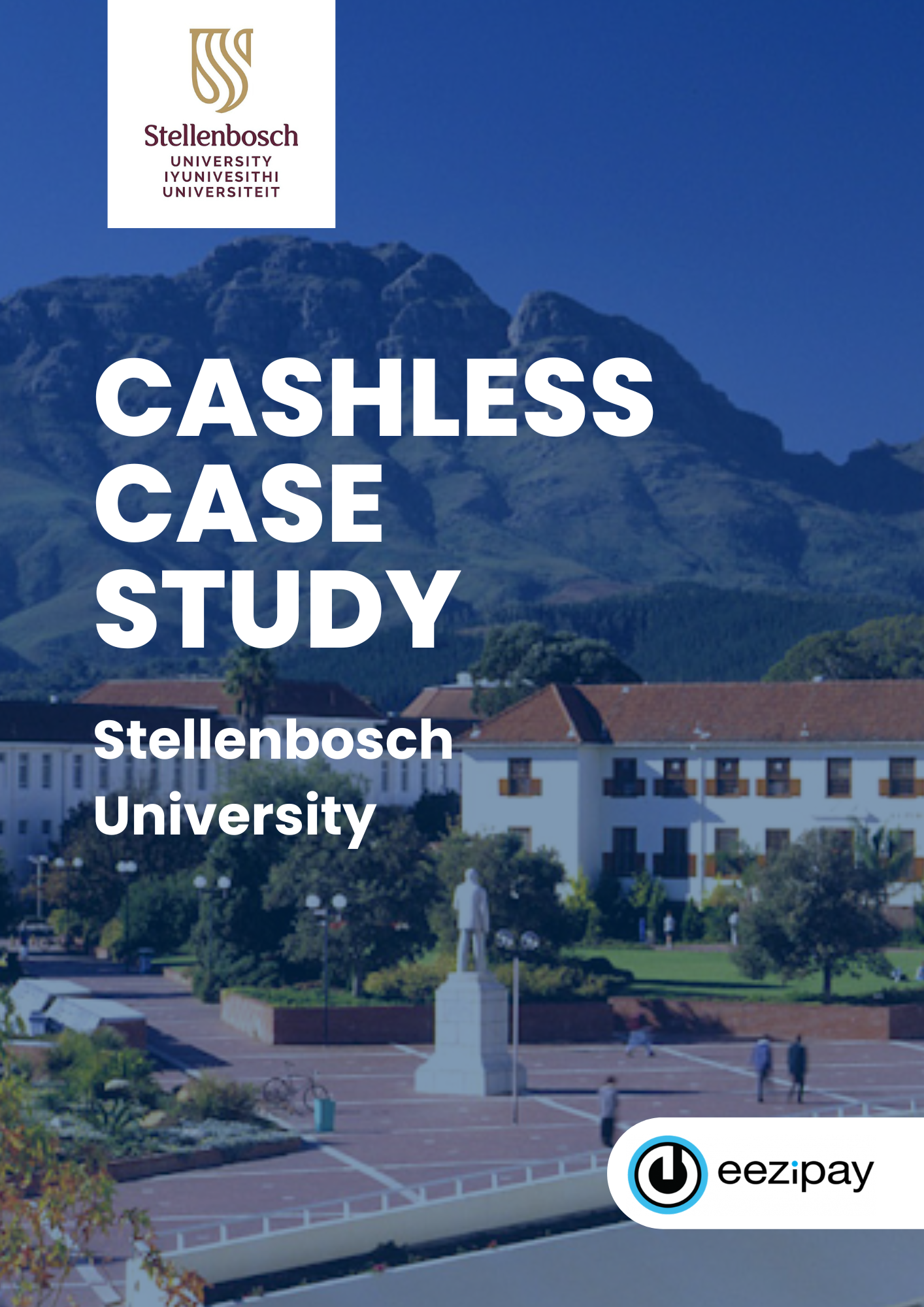Running a school or campus canteen isn’t just about serving meals — it’s about managing operations efficiently, keeping queues short, and tracking every transaction accurately. Whether you’re overseeing a single tuckshop at a primary school or a network of vendors across a university, the right point-of-sale (POS) system is essential.
A modern POS system streamlines canteen management by minimising manual work, enhancing accountability, and fostering a safer, cashless environment for students and staff.
In this guide, we’ll help school administrators, bursars, finance teams, and canteen operators understand what POS systems do, why they matter in the education sector, and how to select one that’s tailored to your institution’s needs. From enabling cashless payments and tracking inventory to streamlining reports and reducing losses, we’ll cover everything you need to make an informed decision.
Let’s start by demystifying the basics.
Table of Contents
Understanding the Basics: Defining a Point-of-Sale System
A point-of-sale (POS) system is more than just an electronic cash register. It’s a combination of hardware and software that allows a business—in this case, a school canteen—to process sales, track inventory, generate reports, and integrate with other operational systems.
Think of it as the nerve centre of your canteen: the point where every transaction is recorded, every stock movement is tracked, and every payment is processed, whether by cash, card, QR code, or prepaid student account.
Here are some of the key functions a modern POS system includes:
- Efficient Transaction Processing: A POS system accepts various payment methods, including debit/credit cards, mobile wallets, and QR codes. This flexibility ensures that your students can pay however they prefer, helping to keep lines moving quickly.
- Accurate Calculations: The point-of-sale system automatically calculates the total amount due for each purchase, taking into account taxes, discounts, and special offers. This reduces the risk of human error and ensures consistency across every transaction.
- Receipt Generation: Once a sale is complete, the system generates a detailed receipt. This can be provided either in printed form or digitally, giving customers a convenient and clear record of their purchase.
- Sales Data Tracking: POS systems track every sale made, providing valuable data for your school’s financial reporting. These insights can aid in budgeting, forecasting, and performance monitoring.
- Inventory Management: Managing stock levels is crucial, especially in a busy canteen. A POS system automatically updates inventory in real-time, ensuring that you always know what’s in stock and can prevent reordering or running out of key items.
Two key components power the system’s functionality:
- Hardware: This typically includes a terminal or touchscreen monitor for the cashier, a barcode scanner for inputting items, a receipt printer, and a card reader for processing electronic payments. Some systems even feature cash drawers for secure cash handling.
- Software: This is the engine that drives everything. It manages the POS system’s operations, tracks inventory, generates sales reports, and often integrates with other systems such as student card accounts or campus meal plans.
The Evolution of Point-of-Sale Systems
Point-of-sale systems have come a long way since their inception. Originally, they were simple cash registers designed solely for recording sales. But as technology advanced, POS systems evolved into sophisticated platforms capable of handling various aspects of business management. Today, they do more than process payments – they help with everything from staff scheduling and customer loyalty programs to compliance tracking and advanced reporting.
In South Africa, this evolution is significant. With the growing popularity of cashless payments, students expect fast and seamless transactions that eliminate the need to handle cash. Furthermore, integrating the POS system with student ID cards, meal plans, or even biometric recognition can provide a smooth, cash-free dining experience.
Why It Matters: The Role of Point-of-Sale Systems in School Canteens
Efficiency, transparency, and student experience are key in a school or university setting. A modern point-of-sale system does more than streamline transaction processing; it revolutionises the entire canteen operation. Here’s why point-of-sale systems matter in this environment:
- Faster Service, Shorter Queues
A POS system speeds up every transaction, which is especially valuable during short break times. Students spend less time waiting and more time enjoying their meals. - Accurate and Transparent Billing
Whether students are paying with cash, card, or prepaid meal plans, the system ensures every transaction is recorded and traceable. This improves accountability and helps prevent discrepancies or disputes. - Cashless Options
Schools are increasingly transitioning to cashless environments for enhanced safety and efficiency. A POS system enables tap-and-go payments, mobile payments, and integration with student cards, eliminating the need for students to carry cash. - Meal Plan Integration
POS systems can be linked to student accounts or meal plans, automatically deducting meals from a prepaid balance and tracking purchases. This not only simplifies transactions but also gives parents and administrators insight into spending and nutrition. - Inventory Control
With real-time inventory tracking, kitchen staff can accurately know what is in stock and what needs to be restocked. This helps reduce waste, prevent over-ordering, and ensure that popular items are always available. - Simplified Reporting and Oversight
School administrators can access detailed sales reports, monitor peak hours, and evaluate food preferences. These insights support better planning, budgeting, and supplier negotiations.
A modern POS system enhances speed, improves transparency, and reduces manual work, becoming an essential tool for delivering an organised, efficient, and student-friendly canteen experience.
Common Challenges with Traditional Canteen Systems
Before the rise of digital solutions, many school canteens relied on manual systems such as cash boxes, handwritten records, and basic calculators. While functional at the time, these outdated methods have considerable drawbacks that can affect efficiency, accuracy, and accountability.
Here are some of the most common challenges:
- Long Queues and Slow Service
Manual payment processes delay transactions, creating congestion during short break times and reducing the number of students served. - Human Error and Inaccurate Records
Without automated systems, it’s easy to make mistakes in calculating totals, giving change, or tracking stock levels. - Cash Handling Risks
Handling physical cash increases the chances of loss, theft, or mismanagement, making financial reconciliation more difficult. - Limited Visibility into Sales and Inventory
Without real-time data, canteen managers often have no clear insight into which items are popular, which are overstocked, or when to reorder. - No Integration with Student Accounts
Traditional systems do not allow for account-based purchases or parental oversight, making it difficult to encourage healthy eating or manage spending limits. - Time-Consuming Reporting
Preparing financial or inventory reports manually is time-consuming and prone to errors, particularly with large volumes of sales data. - Inflexible Pricing and Promotions
Adjusting prices, introducing meal deals, or applying discounts is cumbersome and often requires manual recalculations or signage changes.
Modern point-of-sale systems were designed to overcome these exact pain points by providing faster, smarter, and more secure ways of managing a school canteen.
Must-Have Features for School Point-of-Sale Systems
Choosing the right point-of-sale system for your school canteen isn’t just about picking any software. It’s about selecting a solution tailored to the unique needs of a school environment. Here are the essential features to prioritise:
- Student Account Integration
The point-of-sale system should connect to student profiles or ID cards to support prepaid meal plans, track purchases, and facilitate secure, cashless transactions. - Multiple Payment Methods
Support for debit/credit cards, mobile payments, QR codes, tap-and-go, and contactless student cards ensures flexibility and reduces reliance on cash. - Real-Time Inventory Tracking
As items are sold, the system should automatically update stock levels. This helps prevent overselling and supports timely reordering, ensuring the kitchen runs smoothly. - Customisable Menus and Pricing
The system should allow easy updates to daily menus, pricing changes, and the ability to run limited-time offers or student discounts. - Reporting and Analytics
Look for a POS that generates detailed reports on sales, best-selling items, low stock alerts, and peak hours. These insights enable smarter decisions and more efficient operations. - Parental Access and Transparency
Some systems allow parents to view their child’s meal history, spending habits, and even set dietary restrictions providing peace of mind and promoting healthier habits. - Speed and Ease of Use
A user-friendly interface reduces training time for staff and ensures faster service during busy lunch breaks. - Security and Compliance
The system must comply with data protection regulations and provide secure payment processing, particularly when handling student information and digital wallets. - Offline Functionality
Internet outages shouldn’t bring the canteen to a halt. A reliable POS should be able to function offline and sync data when the connection is restored.
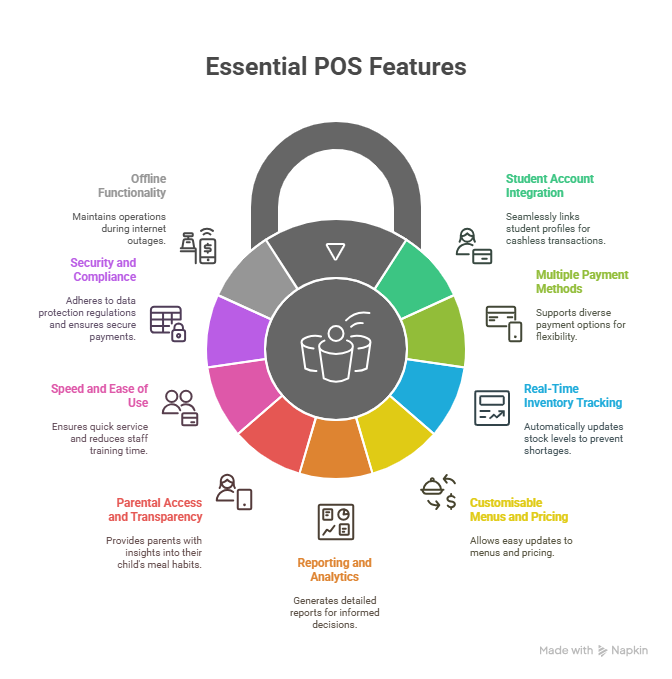
Choosing a point-of-sale system with these features ensures that your school canteen operates smoothly, serves students efficiently, and provides full transparency to parents and administrators alike.
Benefits of Implementing a POS System in Schools
Here are the key advantages: Beyond operational convenience, a point-of-sale system delivers lasting benefits for students, staff, and administrators:
1. Smoother Canteen Operations
- Faster Service During Break Times: Point-of-sale systems speed up checkout, reducing long queues and ensuring that students have enough time to enjoy their meals
- Accurate Sales and Inventory Tracking: Every sale updates stock in real-time, eliminating guesswork and reducing waste.
- Flexible Promotions and Discounts: Daily specials, loyalty rewards, or student discounts can be applied instantly without manual recalculations.
2. Parental and Student Benefits
- Cashless Convenience: Students can pay with cards, mobile wallets, or preloaded accounts, thereby reducing the risks associated with carrying cash.
- Healthier Food Choices and Oversight: With student-linked accounts, parents can monitor food purchases and encourage healthy eating habits.
- Dietary and Spending Controls: Some systems allow parents to set spending limits or block certain items.
3. Administrative & Environmental Gains
- Improved Financial Accountability: Detailed reports enable administrators to effectively monitor sales performance, track revenue, and ensure proper cash management.
- Simplified Compliance and Auditing: Automated records make it easier to meet financial and food-safety reporting standards.
- Environmental Impact: Digital receipts and paperless transaction records support eco-friendly practices by reducing paper waste.
By streamlining canteen operations and promoting transparency, a school POS system enhances the dining experience for students while providing staff and parents with greater control and insight.
Choosing the Right Point-of-Sale System for Your School
Selecting the most suitable point-of-sale system for your school canteen isn’t just about picking the most advanced technology; it’s about choosing a solution that aligns with your specific operational needs, budget constraints, and user capabilities. Here are some critical factors to consider:
1. Ease of Use
Choose a system with a straightforward, user-friendly interface that minimises training and reduces transaction errors.
2. Payment and Integration Flexibility
Opt for a POS that accepts various payment methods (cash, card, mobile, and student accounts) and can integrate with school systems for meal plans or accounting.
3. Inventory and Reporting Tools
Ensure the system includes real-time inventory tracking and generates insightful reports to guide purchasing and menu decisions.
4. Speed and Reliability
Select a solution that can handle high volumes during busy times without delays or technical issues.
5. Cost and Scalability
Evaluate both initial and long-term expenses, ensuring the system can adapt to your school’s evolving requirements.
Explore our comprehensive guide on selecting the ideal cashless solution for your school: How to choose the right cashless solution for your school.
Buyer’s Checklist for School POS Systems
✅ Student integration: Works with student ID cards and prepaid, or bursary-linked accounts.
✅ Cloud reporting: Real-time access for finance teams to reconcile faster.
✅ Education-focused features: Allergen alerts, dietary tracking, and spend limits.
✅ Scalable & supported: Handles everything from single kiosks to multi-campus setups.
Final Recommendation: Tailored POS for Campus Success
Selecting a Point-of-Sale (POS) system for your campus canteen involves choosing a solution specifically designed for educational settings. The best systems integrate cashless payments, student accounts, and real-time reporting into a single platform that evolves with your school.
To deliver these benefits effectively, an ideal cashless campus solution should include the following key capabilities:
- Versatile, All-in-One Payments – covering everything from cafeteria meals to events and bookshop purchases within a single system.
- Student-Centric Integration – linking seamlessly to student IDs and accounts, while being adaptable to innovations like wearables or biometrics in the future.
- Cloud-Based Analytics – providing real-time insights into sales, stock levels, and revenue streams to guide data-driven decisions.
- Education-Focused Design – choosing a platform built for schools and universities, with local support, compliance features, and flexibility to adapt as your institution grows.
That’s why Eezipay’s Cashless Campus POS is built specifically for South African schools and universities. With over 200,000 students served and millions of transactions processed, it has proven to simplify operations, cut costs, and improve the student dining experience.
By choosing a system designed for education, schools can shorten queues, reduce cash risks, and give students and parents the transparency they expect. In short, a tailored POS doesn’t just streamline the canteen — it strengthens the entire campus community.
Ready to Elevate Your School Canteen?
If your institution is still relying on manual systems or outdated tills, now is the time to modernise. A tailored point-of-sale system can help you serve faster, reduce costs, and improve student satisfaction.
Explore our blog on How to Become a Cashless School in 5 ‘Eezi’ Steps or book a free demo to see Eezipay in action.
Let Eezipay help you serve smarter, faster, and with greater transparency.

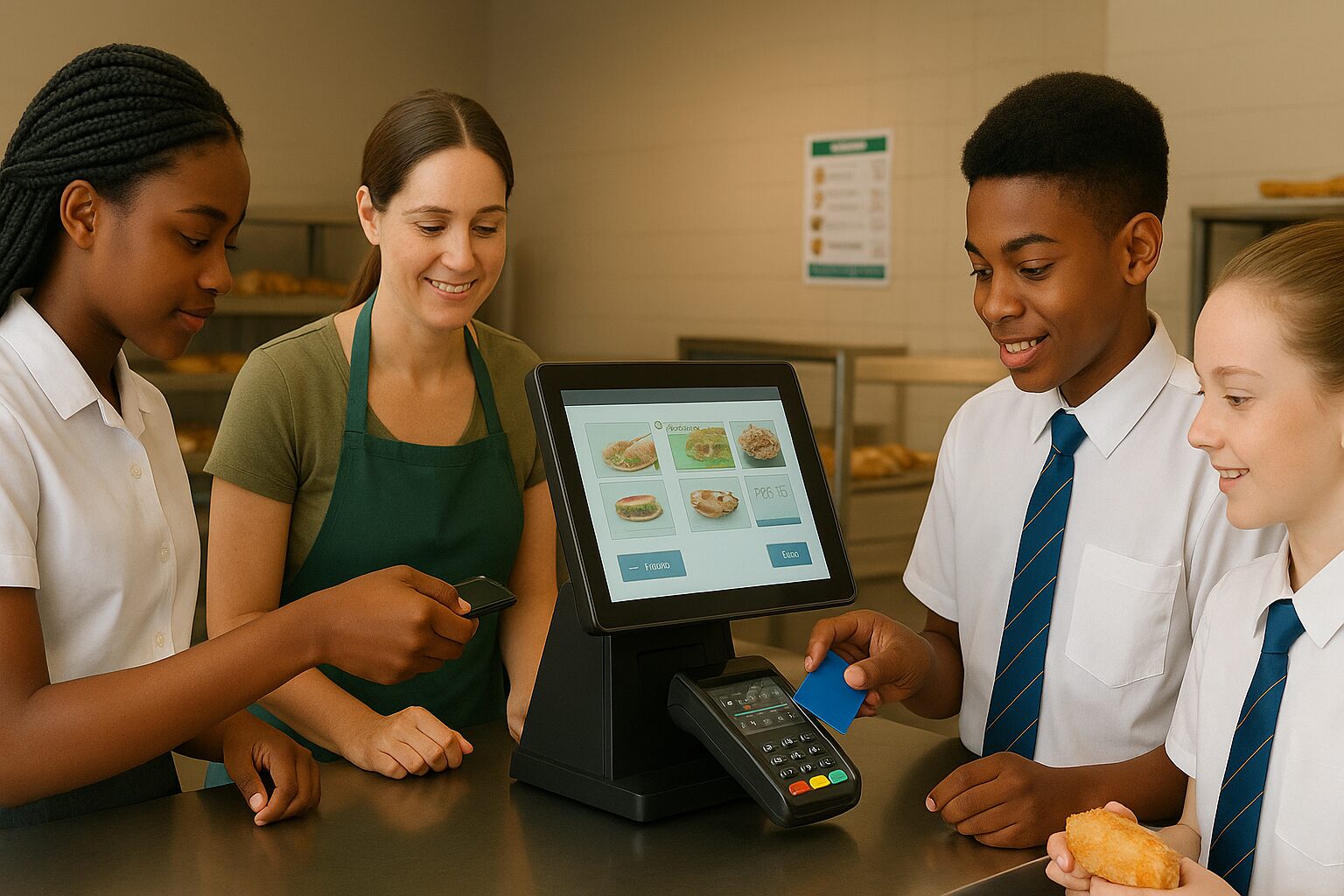
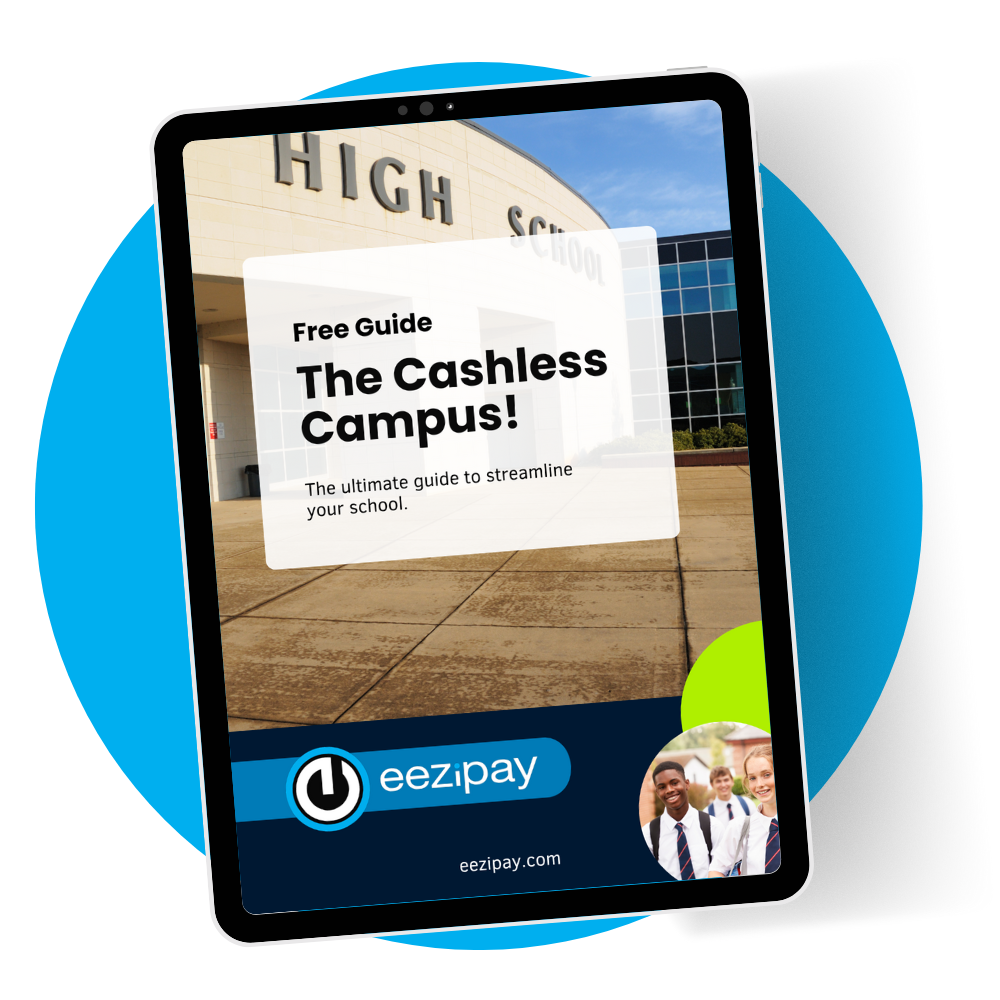
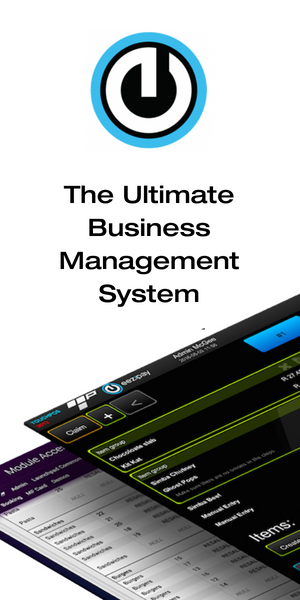
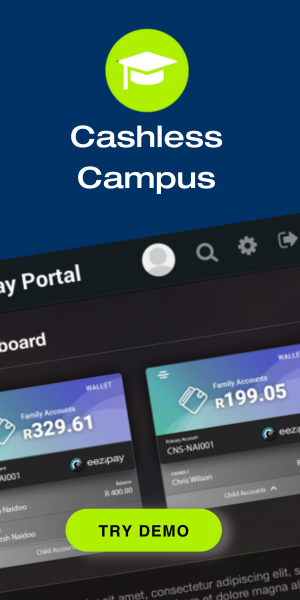
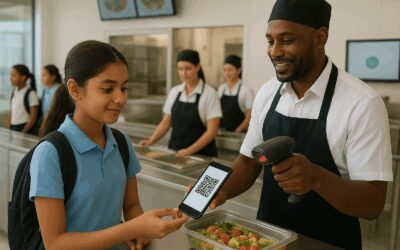
![How QR Code Payments Are Powering a Brighter Future for Universities [2025]](https://eezipay.com/wp-content/smush-webp/2025/05/QR-Codes-Payments-For-Universities-400x250.png.webp)
